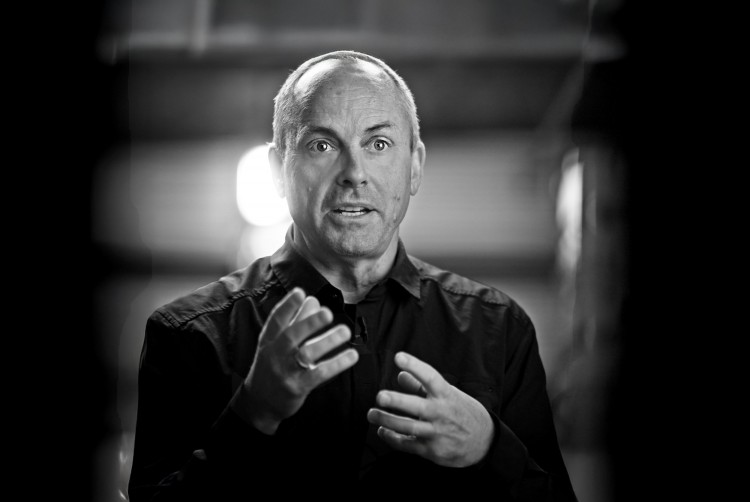
Download PDF
Big Sky Journal - Arts Issue 2001.pdf
Biography
Educated as an exploration geologist, Charles Lindsay is an intermedia artist, Guggenheim Fellow, founder and senior advisor of the SETI Institute’s Artists in Residence Program (AIR), recipient of the Robert Rauschenberg Residency, and Fellow at the Nevada Museum of Art's Center for Art and Environment. Early in his career, Lindsay lived with Shaman Aman Lau Lau Manai of Indonesia’s Mentawai tribe, profoundly shaping his artistic and philosophical perspectives.
At SETI, Lindsay collaborated with astrophysicist Laurance Doyle, whose research applying information theory to humpback whale communication suggested syntactic structures, indicating the possibility for genuine interspecies dialogue. Lindsay’s "CODE Humpback" project integrated these concepts through audiovisual works, using morse code literally and as a metaphor for encrypted signals and unknown languages.
Awarded a Guggenheim Fellowship in 2010 for his "CARBON" series, Lindsay developed a unique process merging photography and drawing, creating images that blur distinctions between microscopic and cosmic scales, digital and organic forms. His work in this series included interactive elements, subtly responding to viewer engagement. “CARBON” was shown widely. "CARBON IV" exhibited at LED LAB NYC (2014), and the CARBON monograph (Minor Matters Books, 2016) features essays by Lyle Rexer and Dr. Jill Tarter.
Lindsay’s "FIELD STATION" modular installations debuted at MassMoCA (2016) and evolved through exhibitions at Des Moines Art Center, Akron Museum of Art, and Beach Museum at Kansas State University. Other notable projects include "Mining the Moon," "Karesansui on MARS," and sound-based works such as "the Sound of a Quantum Computer Thinking," recorded at NASA Ames Quantum AI Lab, and "Ecotone," which simulates post-Earth environments using live sound data from the OSA EARS initiative—an environmental project designed to deliver high-resolution real-time audio from one of the world’s greatest rain forests on the OSA peninsula in Costa Rica. OSA Ears was initially in development with Bell Labs.
Recent lectures include Kyoto University of the Arts, Sónar Music Festival, Chronus Art Center Shanghai, RISD, CalArts, ApexArt, Rhodes Scholars Oxford, Moogfest, California Academy of Sciences, Stanford University, DARPA’s 100 Year Starship Symposium, American Museum of Natural History, Mountain Film, Pratt Institute, SwissNex, Gray Area, and SETI’s Hat Creek Observatory.
Lindsay is the author of eight photography books published by Aperture, Little Brown, Minor Matters, Chelsea Green, Terranova, and MIT Press, with his work featured in New York Times Magazine, Aperture, Orion, GEO, and others. His work has been profiled by WIRED, NPR, CNN International, and prominent Japanese publications.
Additionally, Lindsay conceived and performed three interdisciplinary music projects—"The Electrosense of Paddlefish," "Trout Fishing in Space," and "NEAR(ER)"—combining electric cello, electronics, processed field recordings, modular synths, and visuals, presented at venues including Ear to the Earth Festival and USC’s Visions + Voices series.
Selected Permanent Collections
Houston Museum of Fine Arts, Houston, TX
Philadelphia Museum of Art, Philadelphia, PA
Private collection of Michael Keaton
Private collection of Thomas McGuane
Private collection of Thomas Weisel
Educated as an exploration geologist, Charles Lindsay is an intermedia artist, Guggenheim Fellow, founder and senior advisor of the SETI Institute’s Artists in Residence Program (AIR), recipient of the Robert Rauschenberg Residency, and Fellow at the Nevada Museum of Art's Center for Art and Environment. Early in his career, Lindsay lived with Shaman Aman Lau Lau Manai of Indonesia’s Mentawai tribe, profoundly shaping his artistic and philosophical perspectives.
At SETI, Lindsay collaborated with astrophysicist Laurance Doyle, whose research applying information theory to humpback whale communication suggested syntactic structures, indicating the possibility for genuine interspecies dialogue. Lindsay’s "CODE Humpback" project integrated these concepts through audiovisual works, using morse code literally and as a metaphor for encrypted signals and unknown languages.
Awarded a Guggenheim Fellowship in 2010 for his "CARBON" series, Lindsay developed a unique process merging photography and drawing, creating images that blur distinctions between microscopic and cosmic scales, digital and organic forms. His work in this series included interactive elements, subtly responding to viewer engagement. “CARBON” was shown widely. "CARBON IV" exhibited at LED LAB NYC (2014), and the CARBON monograph (Minor Matters Books, 2016) features essays by Lyle Rexer and Dr. Jill Tarter.
Lindsay’s "FIELD STATION" modular installations debuted at MassMoCA (2016) and evolved through exhibitions at Des Moines Art Center, Akron Museum of Art, and Beach Museum at Kansas State University. Other notable projects include "Mining the Moon," "Karesansui on MARS," and sound-based works such as "the Sound of a Quantum Computer Thinking," recorded at NASA Ames Quantum AI Lab, and "Ecotone," which simulates post-Earth environments using live sound data from the OSA EARS initiative—an environmental project designed to deliver high-resolution real-time audio from one of the world’s greatest rain forests on the OSA peninsula in Costa Rica. OSA Ears was initially in development with Bell Labs.
Recent lectures include Kyoto University of the Arts, Sónar Music Festival, Chronus Art Center Shanghai, RISD, CalArts, ApexArt, Rhodes Scholars Oxford, Moogfest, California Academy of Sciences, Stanford University, DARPA’s 100 Year Starship Symposium, American Museum of Natural History, Mountain Film, Pratt Institute, SwissNex, Gray Area, and SETI’s Hat Creek Observatory.
Lindsay is the author of eight photography books published by Aperture, Little Brown, Minor Matters, Chelsea Green, Terranova, and MIT Press, with his work featured in New York Times Magazine, Aperture, Orion, GEO, and others. His work has been profiled by WIRED, NPR, CNN International, and prominent Japanese publications.
Additionally, Lindsay conceived and performed three interdisciplinary music projects—"The Electrosense of Paddlefish," "Trout Fishing in Space," and "NEAR(ER)"—combining electric cello, electronics, processed field recordings, modular synths, and visuals, presented at venues including Ear to the Earth Festival and USC’s Visions + Voices series.
Charles Lindsay: The Edge of Vision Interview Series from Aperture Foundation on Vimeo.
Selected Permanent Collections
Houston Museum of Fine Arts, Houston, TX
Philadelphia Museum of Art, Philadelphia, PA
Private collection of Michael Keaton
Private collection of Thomas McGuane
Private collection of Thomas Weisel